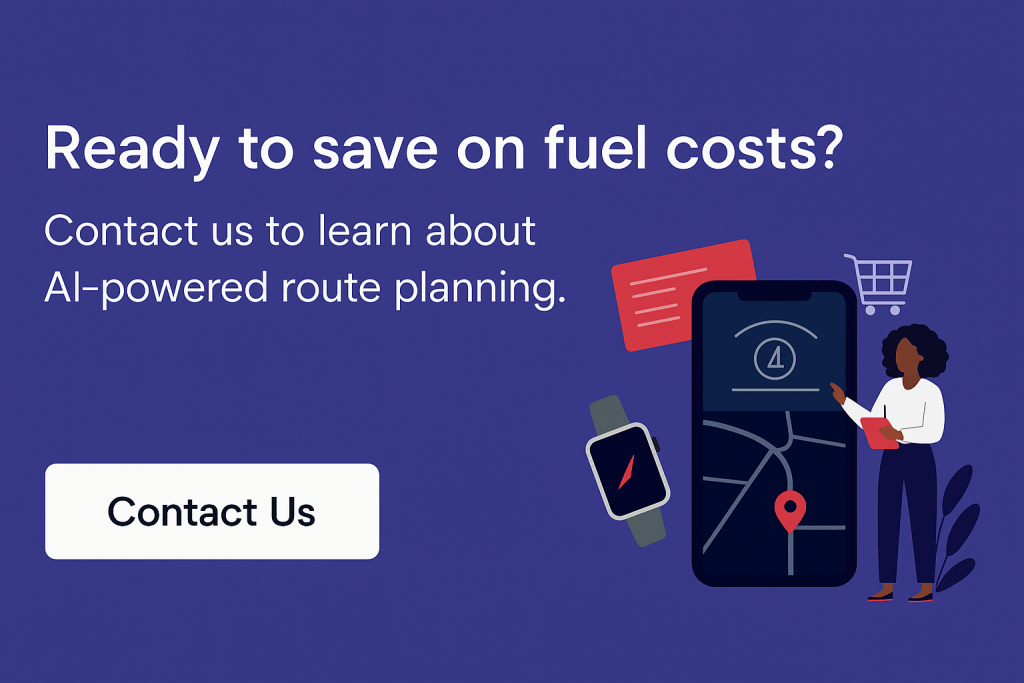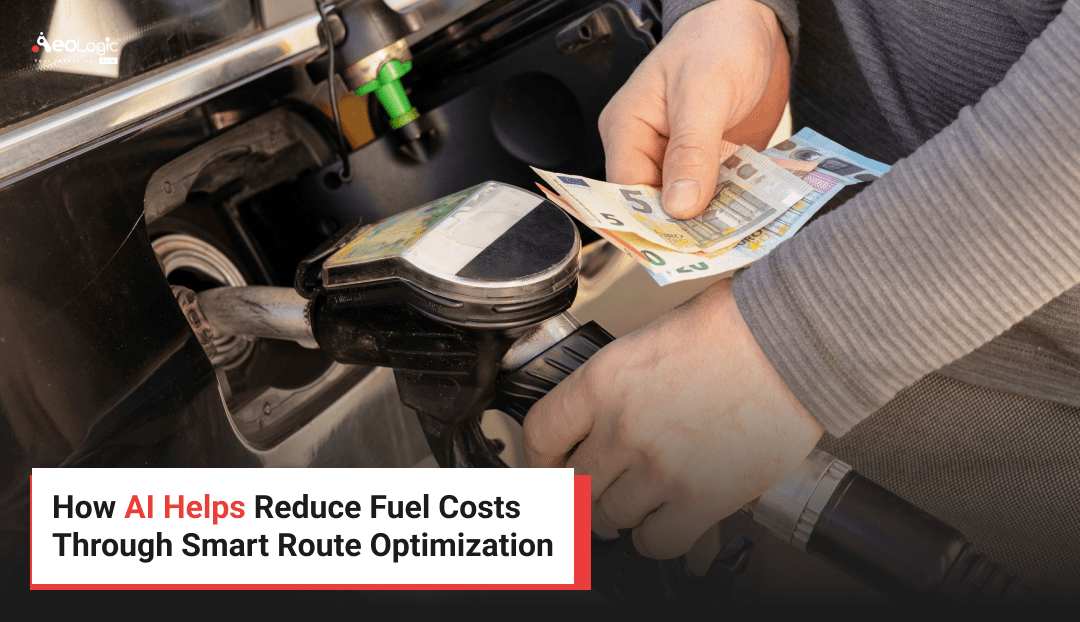Using artificial intelligence (AI) to automate and improve route planning enables businesses to reduce costs, increase productivity, and provide faster, more reliable service.
With factors such as traffic, weather, and real-time data all at play, AI-powered solutions are converting route planning from a time-consuming, manual effort to a dynamic, data-driven solution that adjusts to real-time conditions. As more businesses strive to enhance operational efficiency and customer satisfaction, understanding AI route optimization has never been more important.
Various industries, such as logistics, delivery, travel agencies, and transportation, are facing issues of high costs because they are unable to optimize their routes more effectively. The fuel cost is rising steadily, especially in regions that import fuel from other countries or regions. The rising price of fuel and also not any significant tools or solutions for better route optimization, reduces or cuts off the profit margins for various industries, especially for logistics, which deal with larger shipments and deliver on long routes.
By integrating an AI route optimization solution with real-time data and advanced tracking, industries can significantly reduce fuel consumption, adapt to dynamic conditions, and boost profit margins, especially for logistics handling large shipments over long routes. But first, we understand what route optimization is and why it is important.
The Growing Role of AI in Route Optimization
Route optimization is essential for organizations looking to maximize earnings and minimize fuel expenses because it simplifies delivery routes, cuts down on travel time, and eliminates superfluous mileage. Businesses may save on fuel usage, boost delivery effectiveness, and enhance overall logistics operations by optimizing their routes.
A more sustainable business model, increased customer happiness, and significant cost reductions result from this. Artificial intelligence is the technology that has the potential to optimize routes in a better way by enhancing various aspects that overall cut down the fuel costs significantly.
A nationwide courier service that switched to an AI-driven route optimization platform saw a 28% reduction in fuel costs within six months. Another study showed that using an optimized route instead of a regular route could reduce fuel consumption by 62% for a tree maintenance truck.
The global artificial intelligence (AI) in logistics market size is calculated at USD 26.35 billion in 2025 and is forecasted to reach around USD 707.75 billion by 2034, accelerating at a CAGR of 44.40% from 2025 to 2034.
The route optimization software market grew from $7.75 billion in 2024 to $8.86 billion in 2025 at a compound annual growth rate (CAGR) of 14.3%. It will grow to $15.22 billion in 2029 at a compound annual growth rate (CAGR) of 14.5%.
AI route planning is quickly becoming an important tool in fleet management as companies try to be more productive and make more money. Companies can switch from planning things by hand to using advanced systems that offer flexible solutions when they use software driven by AI.
When conditions change, these systems instantly change routes and schedules based on historical data and real-time information. This helps businesses stay ahead of the competition and make more money.
Explore more: The Rise Of AI In The Transportation Industry
How Outdated Routing Systems Cause Fuel Waste in Logistics
The outdated routing system causes various inefficiencies that result in the waste of fuel for the logistics industry. The conventional or outdated routing system causes longer routes, longer travel times, trapped in traffic due to no idea, bad mileage of the vehicle, all resulting in unnecessary and more fuel consumption that overall affects the costs.
Statistics show that 30% of fuel waste is due to inefficient routes, as this number is not less when it comes to long routes and deliveries. Many other aspects can be the reason cost to more due to inefficient routines like increased labor costs, higher vehicle maintenance costs, higher delivery costs, and a bad consumer experience.
A custom AI Solution for Your Business can enhance route optimization on its own by considering various factors like traffic, weather, and delivery windows. Continuous learning and adaptability for the various aspects lead to reduced costs, increased efficiency, and much more.
Explore more: How To Reduce Your Logistics Costs With Route Optimization
What is AI Route Optimization and How Does It Work?
AI route optimization refers to a system that uses AI or an Artificial Intelligence algorithm to get the best route and ways to deliver that increase the efficiency and route optimization to reduce fuel costs. The AI generally analyzes the data gathered about the route, traffic, weather, vehicle, and weight loaded, to minimize and find the best possible route for faster delivery with the least fuel consumption. Generally, the AI route optimization works in various steps as mentioned below.
- AI systems and IoT devices collect data about different aspects.
- The machine learning algorithm analyzes the data to find patterns about the route and possible road closures.
- On the basis of the analysis, the AI finds the best possible route that is short and smooth.
- After finding a route, AI can also make dynamic changes if any sudden problems appear on the previous route.
- The AI system provides real-time updates about the route and conditions that enhance decision-making.
Also Read: The Role of AI in Flight Scheduling and Route Optimization
How does AI Route Optimization Work?
AI algorithms are employed to process complicated data and offer the most optimal solution for fleet management through route optimization. The process commences with the collection of pertinent data points, including traffic conditions, vehicle capacity, and delivery addresses. After this, the AI system employs machine learning models to analyze the data and determine the most efficient routes.
Fuel consumption, delivery time, and driver behavior are all components of this methodology. AI has the ability to anticipate potential obstacles, including traffic congestion, incidents, or inclement weather, and modify routes accordingly.
The system also ensures that the fleet operates at optimal efficiency by adapting to real-time changes. This integration of real-time governance and historical data analysis offers a competitive advantage in route planning, thereby reducing operational expenses and improving customer satisfaction. 
Top Ways AI Route Optimization Reduces Fuel Costs
There are various ways that AI route optimization can reduce fuel costs. Here are the top 5 ways mentioned below.
Real-Time Traffic Analysis
The AI-powered route optimization solutions can analyze the data gathered about traffic control all around the route. This helps to provide the traffic level at every stage of the route. Also, provide alternative options of routes that do not have too much traffic and are also smooth. The AI route optimization enables predictive routing that slows down the hazardous all around to save fuel costs.
Multi-stop and Last Mile Optimization
Multi-stop and last-mile optimization become important in the fast-paced world. The AI route optimization solutions enable proper planning and execution in the multi-stop deliveries as which deliveries should be made first among multiple stops. This includes factors like locations, delivery time window, vehicle capacity, traffic and weather conditions, etc.
Last Mile Optimization
The last-mile delivery optimization includes a focus on the last stage of the delivery process from direct warehouses to the consumer’s doorstep. This also involves various factors like locations, consumer preferences, delivery windows, etc. The AI route optimizes every factor in both conditions and provides the best delivery strategies to save fuel and time.
Also Read: How IoT and AI are Transforming Logistics?
Dynamic Scheduling
There could be a rush at a specific time and you should avoid the delivery at that time. The AI route optimization helps to analyze the data about the traffic, weather, rush, etc to find the exact time of rush that you can avoid in that time slot. Also by integration with the driver and vehicle apps, you can dynamically schedule the delivery for the best possible time that does not involve vehicle congestion and rush.
Coaching For Fuel-Efficient Driver Behaviour
Driver behaviors and driving style also make an impact on fuel consumption and route optimization for the delivery. The AI route optimization system helps to detect the driver’s behavior in real-time, like harsh driving, sudden braking, and speeding.
The AI-powered system automatically triggers the warning in any such conditions and also provides real-time coaching for the driver to enhance their driving methods. This overall improves the delivery efficiency and fuel consumption, which saves costs. Statistics show that AI-led driving feedback reduces fuel costs by up to 15%.
Route Consistency and Pattern Learning
It is not possible to get the pattern of wasting fuel in just a single delivery, but the AI route optimization system can detect or analyze the pattern of fuel consumption by analyzing various delivery data. This helps to continuously update routing models based on historical performance. This provides great results on proper route optimization with the AI that reduces costs and time and enhances efficiency for the deliveries.
Benefits of AI-Driven Route Optimization
These are fundamental benefits of utilizing AI for route planning.
1) Fuel Efficiency
AI selects shorter, faster routes, hence improving fuel efficiency. It also helps drivers avoid long stretches of idle time in traffic. According to research, AI can save gasoline costs by up to 20%. A small fleet can save thousands of dollars in operating expenditures each year.
2) Accelerated Delivery Timelines
AI helps fleets deliver goods on time by identifying the quickest and most direct routes. To ensure operational efficiency, it estimates delivery windows and adjusts routes in the event of delays. Customers can receive updates from certain systems that tell them when to expect their delivery. These attributes improve customer happiness and service quality.
3) Enhanced Utilization of the Fleet
Fleet firms use AI-powered route planning tools to optimize their fleet efficiency. They employ artificial intelligence (AI) to assess the overall route conditions and plan accordingly. Businesses may consider how many vehicles will be required to execute a certain task. The proper cars and drivers are subsequently assigned to each assignment. It saves them money and keeps them from sending out additional trucks.
4) Decreased Maintenance Costs
AI route optimization tools analyze historical data and fleet performance to predict the need for vehicle maintenance. When AI detects that a car need repairs or services, you can schedule maintenance right away. You can get your car repaired before it develops a significant problem or fails.
5) Environmentally Sustainable Practices
AI-powered route optimization tools help fleet managers uncover faster, more efficient routes. Their fleets utilize less fuel and arrive at their destinations quickly. As a result, they emit fewer pollutants, which benefits the environment. According to one study, improving your route can save greenhouse gas emissions by 10% every month.
Also Read: Using AI to Optimize Business Processes & Reduce Costs
How AI Route Optimization Saves Your Fleet?
Artificial intelligence (AI) can drastically cut fleet expenses by reducing fuel consumption, mileage, and delivery times by properly analyzing the routes of deliveries.
According to McKinsey research, improved routing can cut mileage by up to 20%, which translates into real financial savings.
According to some estimations, boosting truck usage and reducing idle kilometers might result in delivery cost reductions of up to 40%. Route optimization and fuel saving with AI can be achieved by various methods like real-time data analysis, machine learning, dynamic route optimization, vehicle capacity optimization, green routing, and dynamic route planning APIs.
The smart routing features with the AI not only save fuel consumption and costs but also enhance route efficiency and fleet management optimization in a much better way than ever before.
Also Read: How Automation Solutions Address 6 Major Pain Points in Logistics
Final Take
With the digital transformation and advancement in digitalization, AI-driven route optimization has surpassed human capabilities with great applications and benefits. The AI route optimization enables smart routing, faster data analysis, dynamic adaptability, multi-variable optimization, consistency, and scalability, much better than human potential.
Applications in the real world demonstrate the clear advantages of incorporating cutting-edge technology into logistics. These achievements show how well AI works for route optimization and its broader ramifications for companies looking to stay innovative and competitive in the digital era. One of the most important use cases of AI route optimization is real-time data analysis and behavior that boosts the decision-making ability in panic situations and pressure handling in a much more efficient way.
Overall, if any industry, especially the logistics industry, wants to enhance route optimization and cut down expenses, then AI-powered route optimization could be the best solution for them. They should make immediate and right decisions to adapt this technology to make a profit.
If you are looking AI solution for your business, connect with Aeologic Technologies to grow your business.
Don’t forget to share this with any logistics team battling fuel costs.
FAQs
How does AI improve route optimization compared to traditional methods?
AI uses real-time data like traffic, weather, and road conditions combined with historical patterns to create the most efficient routes. Unlike traditional static maps, AI continuously updates routes to avoid delays, reducing unnecessary mileage and fuel consumption.
Can AI route optimization really reduce fuel costs significantly?
Yes! By minimizing travel distance, avoiding traffic jams, and optimizing driving speeds, AI can reduce fuel consumption by up to 20-30%, leading to substantial savings for logistics and transportation companies.
What types of data does AI use to optimize routes for fuel efficiency?
AI systems analyze GPS data, live traffic updates, weather forecasts, vehicle load, delivery time windows, and road restrictions. This comprehensive data allows AI to plan routes that save fuel and time.
Is AI-based route optimization easy to integrate with existing fleet management systems?
Most modern AI route optimization solutions are designed for easy integration via APIs with popular fleet management platforms. This seamless setup allows businesses to upgrade their routing without overhauling existing systems.
Besides fuel savings, what other benefits does AI route optimization offer?
AI route optimization improves delivery times, reduces vehicle wear and tear, lowers labor costs by minimizing driver hours, and enhances customer satisfaction with more accurate ETAs.

I’m Deepika Pandey, an SEO strategist and content writer with 6+ years of experience. I create SEO-friendly content that drives traffic and engages readers. I combine data insights with creativity to help businesses grow their online presence effectively.






